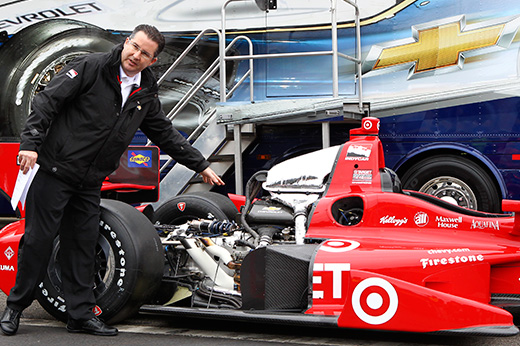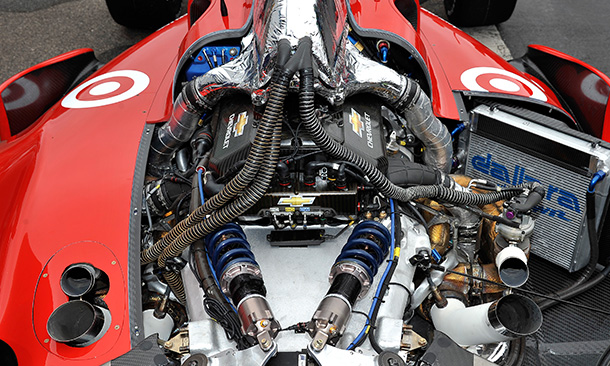Postcard from Barber: Chevy engine unwrapped
MAR 18, 2014
BIRMINGHAM, Ala. -- Chris Berube contends that some of the best innovations come to fruition from constraints.
The program manager for Chevrolet Racing (photo below) pointed out features of the 2.2-liter, direct-injected, twin-turbocharged V6 engine fueled by E85 that will be used for the 2014 Verizon IndyCar Series season. Behind the No. 10 Target Chip Ganassi Racing car, which was used as a model for the stressed member of the car, was a 2014 Chevrolet Malibu with a 2-liter, direct-injected, turbocharged 4-cylinder engine to note the relevance between the racing and consumer products.
“There is a linkage. Similar technologies that we’re racing with are for sale in our vehicles,” Berube said. “That’s part of the value of why we race is these linkages and technology transfers to the showroom.”
Within the INDYCAR constraints for the engines supplied by Chevrolet (with partner Ilmor Engineering) and Honda Performance Development, engineers seek performance advantages within the rules through – and other items – managing the air and fuel mixture for more power and increased fuel economy.
Engine manufacturers have some leeway in development, such as a 20 percent larger volume plenum (the chamber or reservoir of air that supplies the engine) for 2014 and new valve sizing and porting of cylinder heads. They’re also up against an increased durability mandate for the 18-race season to 2,500 miles between overhauls. Each entry is allowed four fresh engines for the season, with the count starting at the Open Test this week at Barber Motorsports Park.
“Those are pretty big challenges for an engineering team to execute on,” Berube said.
Honda for 2014 has joined Chevrolet in developing and producing a twin-turbocharged engine. Both use the BorgWarner Turbo Systems’ model 7163, which is new for 2014.
Some specs for the Verizon IndyCar Series engines
Horsepower rating: 575 for superspeedways, 625 for 1.5-mile ovals, 675 for road/street courses
Capacity: 2,200 cc (134 cubic inches)
Weight: 248 pounds
Block and head material: Aluminum
Maximum RPM: 12,000, with 12,200 when overtake assist engaged
Oil system: Dry sump lubrication
Camshaft: Double overhead camshaft
Gear shift: Steering wheel paddle shift system
Intake system: Carbon fiber single plenum























